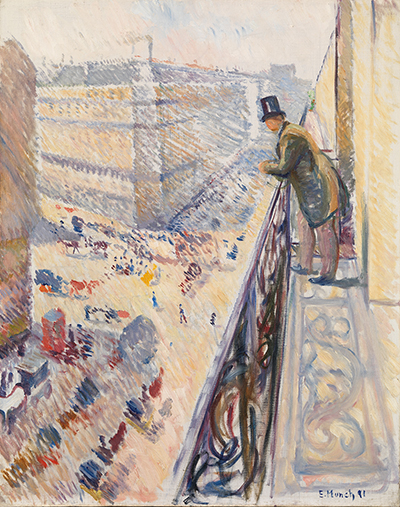Spring, 1891. La Belle Epoque is a pulse-beat away, and the city of Paris is bustling, vital, brimming with life and art and glamour.
Edvard Munch is living in the centre of the exciting city, in Rue Lafayette, number 49, just near the junction with Rue Faubourg-Montmartre and Rue Drouot. He has decided to capture it all on canvas. During the second part of the 19th century, Paris acquired a new look. Napoleon III had commissioned Baron Haussmann to modernise the city, straighten the roads and sort out the sewers. This modernisation gave birth to wide-sweeping avenues and grand imposing buildings, to Paris as we know it today. Unfortunately, much of the old medieval Paris got destroyed, but the magnificent city that rose from the ashes was a new beauty, admired and desired. Artists, writers, intellectuals flocked to the city to breathe and live its imperial glamour. Paris became the centre of European art. It had the power to inspire. It still does.
Munch did not hesitate when, in 1889, he received a bursary from the Norwegian state. He took off for the artistic centre of the universe. Paris was the only place to be at this time. And Paris worked its magic; he was impressed and inspired. Munch had living quarters in a prime position, practically in the town centre, at the heart of the action. He just had to look outside his room to feel the pulse of the city. And he did, and he transferred this exciting vitality onto his canvas. Munch's Parisian painting shows us the grand boulevards of Paris seen from above. We presume from Munch's balcony. The elegant gentleman leaning on the balcony balustrade is looking down on the bustling boulevard, drinking in the scene. Similarly, any gallery visitor, contemplating the picture, can enjoy the same view.
The street, far below, presents the day-to-day comings and goings in the bustling capital. The city traffic, the light and shade, the Parisians going about their business are all portrayed using impressionist techniques. Short, sharp brush strokes define the shadows, and the busy-ness of the street is represented by dots or blurs which convey the dynamic nature of the scene. Take a step back, and everything falls magically into place. In this period, not surprisingly in turn-of-the-century Paris, Munch was very much influenced by Impressionism. Only later, his painting took other directions, and he came to be known as the father of Expressionism. Rue Lafayette is oil on canvas, measuring 92 x 73 cm. It was acquired (funds donated by Olaf Schou) in 1933 for the National Gallery in Oslo, Norway, where it currently hangs.




